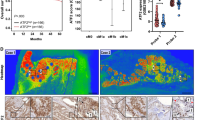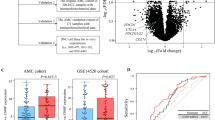Abstract
Background
Trophinin-associated protein (TROAP) is a cytoplasmic protein that functions as an adhesion molecule in processes such as embryo implantation, spindle formation, and cancer.
Objective
To evaluate the relationship of TROAP expression in hepatocellular carcinoma (HCC) tissue with clinicopathologic parameters and survival time in liver cancer patients based on an analysis of The Cancer Genome Atlas Liver Hepatocellular Carcinoma (TCGA-LIHC) data.
Methods
RNA-sequencing (RNA-Seq) expression data and clinical information were downloaded for the TCGA-LIHC cohort. Associations between TROAP expression in HCC tissues and clinical parameters were evaluated by Chi-square tests. Differences in survival between high and low expression groups (median expression cutoff) from Cox regression analysis were compared, and P values were calculated by a log-rank test. Kaplan–Meier curves were compared with the log-rank test.
Results
Analysis of RNA-Seq gene expression data for 373 patients with primary tumors revealed overexpression of TROAP in liver cancer. High TROAP expression was associated with survival status (P = 0.015), T stage (P = 0.049), clinical stage (P = 0.048), and gender (P = 0.033). Patients with high TROAP-expressing liver cancers had a shorter median overall survival of 3.83 years compared with 5.80 years for patients with low TROAP-expressing liver cancers (P = 0.00422). Multivariate analysis identified TROAP expression as an independent prognostic variable for overall survival in liver cancer patients.
Conclusion
TROAP expression is an independent predictor of poor survival in liver cancer.


Similar content being viewed by others

References
Fukuda MN, Sugihara K. Cell adhesion molecules in human embryo implantation. Sheng Li Xue Bao. 2012;64:247–258.
Fukuda MN, Sato T, Nakayama J, et al. Trophinin and tastin, a novel cell adhesion molecule complex with potential involvement in embryo implantation. Genes Dev. 1995;9:1199–1210.
Suzuki N, Zara J, Sato T, et al. A cytoplasmic protein, bystin, interacts with trophinin, tastin, and cytokeratin and may be involved in trophinin-mediated cell adhesion between trophoblast and endometrial epithelial cells. Proc Natl Acad Sci U S A. 1998;95:5027–5032.
Aoki R, Fukuda MN. Recent molecular approaches to elucidate the mechanism of embryo implantation: trophinin, bystin, and tastin as molecules involved in the initial attachment of blastocysts to the uterus in humans. Semin Reprod Med. 2000;18:265–271.
Fukuda MN, Nozawa S. Trophinin, tastin, and bystin: a complex mediating unique attachment between trophoblastic and endometrial epithelial cells at their respective apical cell membranes. Semin Reprod Endocrinol. 1999;17:229–234.
Fukuda MN, Sugihara K. Trophinin in cell adhesion and signal transduction. Front Biosci (Elite Ed). 2012;4:342–350.
Sugihara K, Sugiyama D, Byrne J, et al. Trophoblast cell activation by trophinin ligation is implicated in human embryo implantation. Proc Natl Acad Sci U S A. 2007;104:3799–3804.
Fukuda MN. Molecular basis of embryo implantation. Keio J Med. 1996;45:37–43.
Yang S, Liu X, Yin Y, Fukuda MN, Zhou J. Tastin is required for bipolar spindle assembly and centrosome integrity during mitosis. FASEB J. 2008;22:1960–1972.
Godoy H, Mhawech-Fauceglia P, Beck A, et al. Developmentally restricted differentiation antigens are targets for immunotherapy in epithelial ovarian carcinoma. Int J Gynecol Pathol. 2013;32:536–540.
Partheen K, Levan K, Osterberg L, et al. Four potential biomarkers as prognostic factors in stage III serous ovarian adenocarcinomas. Int J Cancer. 2008;123:2130–2137.
Jing K, Mao Q, Ma P. Decreased expression of TROAP suppresses cellular proliferation, migration and invasion in gastric cancer. Mol Med Rep. 2018;18:3020–3026.
Ye X, Lv H. MicroRNA-519d-3p inhibits cell proliferation and migration by targeting TROAP in colorectal cancer. Biomed Pharmacother. 2018;105:879–886.
Lian Y, Fan W, Huang Y, et al. Downregulated trophinin-associated protein plays a critical role in human hepatocellular carcinoma through upregulation of tumor cell growth and migration. Oncol Res. 2018;26:691–701.
Samur MJPO. RTCGAToolbox: a new tool for exporting TCGA firehose data. PLoS ONE. 2014;9:e106397.
Team RDCJC. R: A Language and Environment for Statistical Computing, vol. 14. Vienna: R Foundation for Statistical Computing; 2009:12–21.
Wickham H. Ggplot2: Elegant Graphics for Data Analysis. New York, NY: Springer-Verlag; 2009.
Therneau TM, Grambsch PM. Modeling Survival Data: Extending the Cox Model. New York, NY: Springer-Verlag; 2000.
Nadano D, Nakayama J, Matsuzawa S, Sato TA, Matsuda T, Fukuda MN. Human tastin, a proline-rich cytoplasmic protein, associates with the microtubular cytoskeleton. Biochem J. 2002;364:669–677.
Li CW, Chen BS. Investigating core genetic-and-epigenetic cell cycle networks for stemness and carcinogenic mechanisms, and cancer drug design using big database mining and genome-wide next-generation sequencing data. Cell Cycle. 2016;15:2593–2607.
Author information
Authors and Affiliations
Corresponding author
Ethics declarations
Conflict of interest
All authors declare that there are no conflicts of interest.
Rights and permissions
About this article
Cite this article
Jiao, Y., Li, Y., Lu, Z. et al. High Trophinin-Associated Protein Expression Is an Independent Predictor of Poor Survival in Liver Cancer. Dig Dis Sci 64, 137–143 (2019). https://doi.org/10.1007/s10620-018-5315-x
Received:
Accepted:
Published:
Issue Date:
DOI: https://doi.org/10.1007/s10620-018-5315-x



